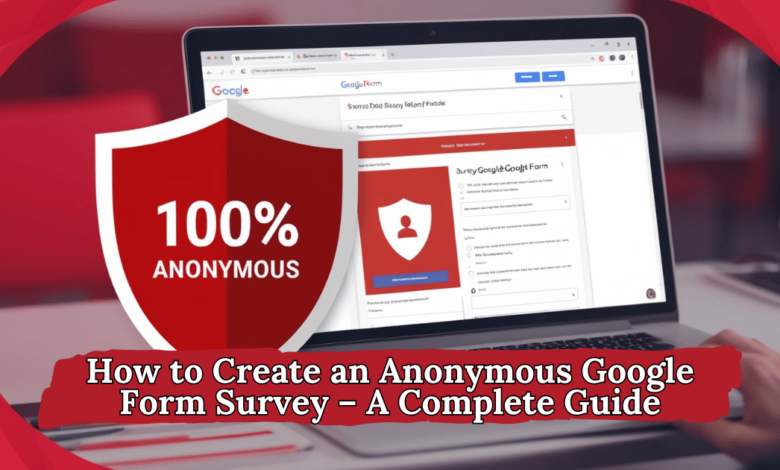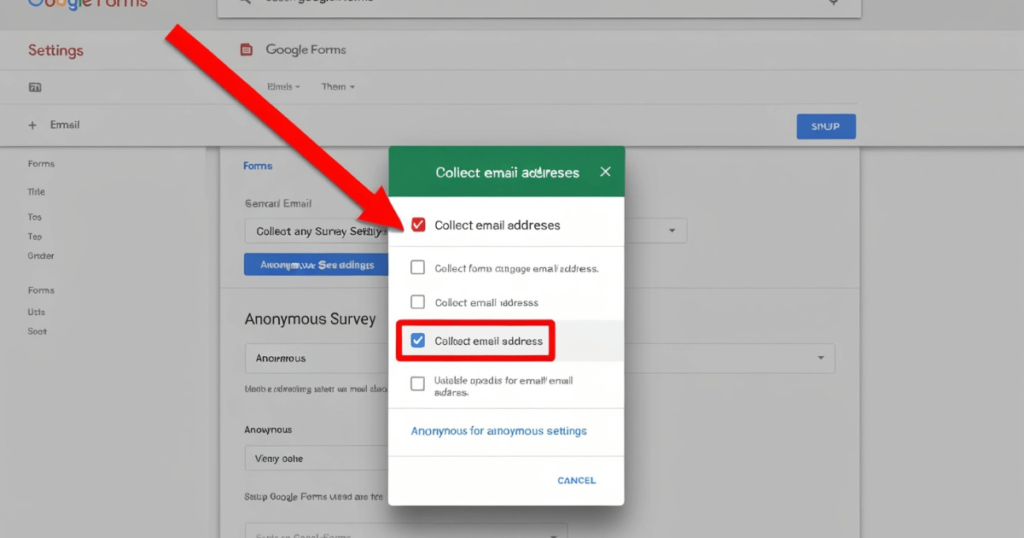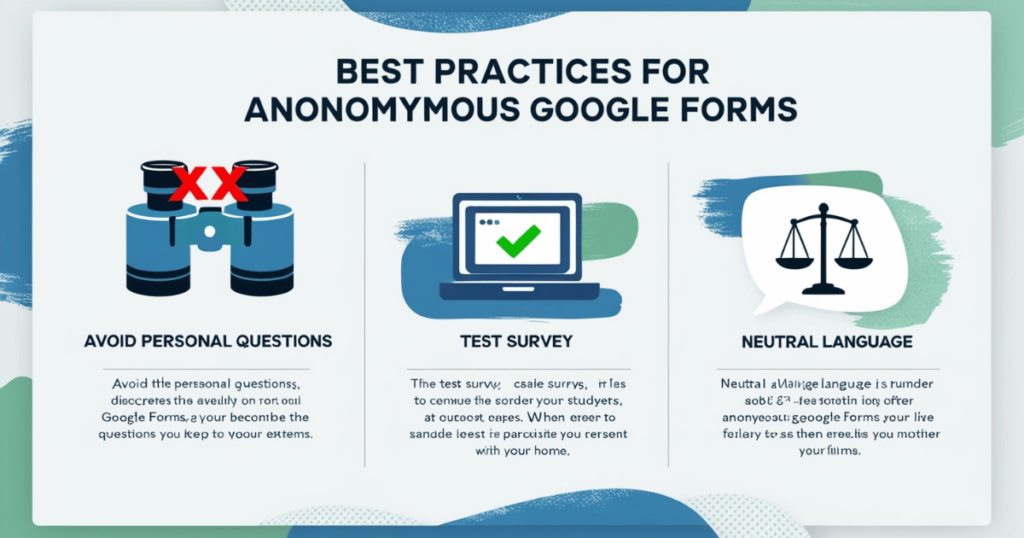
In digital data collection, creating an anonymous Google Form survey has become a primary method for gathering honest and valuable insights. Whether you’re seeking employee feedback, conducting customer satisfaction assessments, or gathering input on sensitive topics, Google Forms offers the flexibility and anonymity required for trustworthy feedback.
Table of Contents
ToggleThis guide provides an in-depth, step-by-step approach to setting up an anonymous Google Form survey while ensuring maximum privacy for respondents. We’ll also explore best practices to enhance response accuracy and build trust with your audience.
What is an Anonymous Google Form Survey?
An anonymous Google Form survey is a survey designed using Google Forms with settings configured to keep the identity of respondents private. The goal of an anonymous Google Form is to collect data without linking responses to any identifying information, such as email addresses or login details, allowing participants to share honest feedback comfortably.
Benefits of Using Google Forms for Anonymous Surveys
1. Free and Accessible
Google Forms is a free tool, and its functionality meets the requirements of most survey types, making it ideal for small businesses, educational institutions, and researchers with limited budgets.
2. User-Friendly Interface
Google Forms is known for its intuitive design, allowing survey creators and participants alike to navigate with ease. Its accessibility encourages higher completion rates, which is critical for reliable data.
3. Real-Time Data Collection
With an anonymous Google Form, responses are immediately updated and stored in Google Sheets, allowing for efficient data analysis and review.
4. Flexible Question Options
Google Forms offers a variety of question formats, including multiple-choice, short answers, and checkboxes. This flexibility supports various data collection strategies while maintaining respondent anonymity.
Setting Up Your Anonymous Google Form Survey
To create an anonymous Google Form survey, follow these steps carefully to configure privacy settings and ensure accurate data collection.

Step 1: Access Google Forms
- Go to Google Forms and sign in with your Google account.
- Click on Blank Form to start a new form, or choose from a template based on your survey requirements.
Step 2: Name Your Form and Describe Its Purpose
Add a relevant title and description that clearly communicates the survey’s purpose. Explain to participants that their responses will be anonymous, which helps build trust and encourages genuine responses.
Step 3: Adjust Settings for Anonymity
- Select the Settings (gear icon) in the top right.
- Under the General tab:
- Uncheck Collect email addresses. This is crucial as it ensures no email identifiers are collected.
- Also, uncheck Limit to 1 response. By leaving this box unchecked, users can respond without signing in, further ensuring anonymity.
Step 4: Choose Anonymous Question Types
- Add questions relevant to your survey topic, selecting question types like multiple-choice, dropdown, or paragraph responses for qualitative input.
- Avoid questions that might inadvertently identify the respondent, such as name, age, or location, unless strictly necessary for your research.
Step 5: Preview and Test Your Survey
Click on the Preview button (eye icon) to review your survey’s format and functionality. Run a test to ensure no identifiable information is being captured.
Ensuring Complete Anonymity in Google Forms
In a standard anonymous Google Form survey, Google does not automatically record IP addresses or any other identifiable data of respondents. However, additional steps can enhance privacy:
Data Handling Practices
After collecting responses, ensure that the data remains anonymous by avoiding any unnecessary data exports or log files that could trace respondents’ answers back to them. Google Sheets can be used to access the data directly without extra downloads or third-party tools, maintaining the integrity of your anonymous Google Form survey.
Limit Access to Collected Data
Restrict access to the Google Form survey results to only those who need it for analysis. Data management policies are essential in protecting respondent information, even when using an anonymous Google Form survey.
Best Practices for Anonymous Google Form Surveys

Maximizing the success and reliability of your anonymous Google Form survey depends on maintaining certain practices during survey design and distribution.
1. Avoid Personal or Sensitive Questions
While anonymous Google Form surveys are designed for privacy, avoid overly personal questions that may deter respondents or lead to dishonesty.
2. Use Clear, Neutral Language
Ensure questions are phrased neutrally to avoid influencing responses. Using neutral language encourages respondents to share their true opinions.
3. Conduct a Pilot Test
Before launching, pilot your anonymous Google Form survey with a small group to identify any privacy issues or glitches in the survey flow.
4. Clarify the Anonymity Policy
Let respondents know that their answers are anonymous. Transparency is key in securing honest feedback and reassuring participants that their privacy is respected.
5. Use Data Objectively
An anonymous Google Form survey should yield impartial data. Be sure to analyze the results objectively, focusing on trends rather than individual answers.
FAQs on Creating Anonymous Google Forms
Q1: Can I confirm that no one will know who responded to my anonymous Google Form survey?
A1: Yes, if you’ve disabled email collection and removed identifying questions, Google Forms does not automatically record IP addresses or track respondents, keeping the survey truly anonymous.
Q2: How can I assure respondents their feedback is private?
A2: Clearly mention in the form description that responses are anonymous and their feedback will not be tracked or linked to any identifiers.
Q3: Can I still limit responses to one per person without requiring sign-in?
A3: Limiting responses typically requires respondents to sign in with Google, which can compromise anonymity. If true anonymity is essential, avoid using this setting.
Q4: Does Google Forms store any metadata that can identify respondents?
A4: Google Forms does not store metadata like IP addresses by default, but for added security, avoid exporting or sharing responses outside Google Sheets.
Q5: Is it possible to track respondents if necessary?
A5: No, once a form is set to be anonymous, there’s no way to trace responses back to an individual, as email collection and sign-in tracking are disabled.



